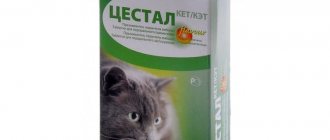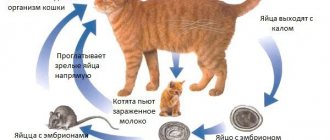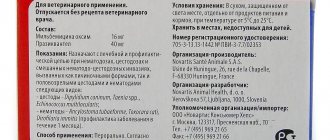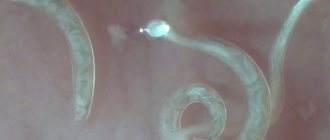At first glance, it seems that there is nothing simpler than giving a cat a pill. In fact, this is far from a simple procedure, since cats, thanks to their love of freedom, absolutely do not tolerate being manipulated against their will. In order to give the cat medicine, you will have to hold it tightly. The first thing he will do at this moment is try to run away quickly, because cats do not tolerate being held tightly.
There are many ways to properly give your pet this ill-fated pill. Their advantage is not only that the medicine will reach its target, but also in the absence of stress for both the cat and its owner.
Basic rules for treatment with anthelmintic drugs:
- The medicine is usually given on an empty stomach.
- The second time the anthelmintic drug should be given after 10 days.
- Every 3 months for preventive actions it is necessary to carry out anthelmintic measures.
- Before you begin deworming, you need to make sure that the animal does not have fleas. If they are present, then it is imperative to get rid of them, and then expel the parasites.
- Before giving an anthelmintic, you need to give a gamavit injection to the withers. 4 hours after taking the anthelmintic, you need to give any sorbents: activated carbon, polysorb, enterosgel.
Basic methods of giving medicine to a cat
Mix with food
This method can be used after first finding out whether the positive effect of taking the tablet will disappear after mixing. This can be read in the instructions for the medicine.
- The tablet must be pre-crushed.
- Mix with your cat’s favorite food, taken in small quantities.
- Make sure that the food is completely eaten. If the cat did not eat everything, then we can say with confidence that the required dose did not enter the animal’s body.
- You can try dividing the tablet into two parts and fixing it either in a sausage or in boiled minced meat. It is important that the lined pieces are small. This is required so that the cat does not chew them, but swallows them whole.
Using butter
Even with a strong desire, the cat will not be able to spit out the tablet. Thanks to the butter, it slips into the throat.
- If the tablet is small, then it needs to be dipped in butter.
- Place the cat as close to the root of the tongue as possible.
- If the tablet is large, it must first be divided into parts.
With a piece of butter
All cats love to eat delicious food, especially butter and any other products in the form of yogurt or sour cream. You can use these products for treatment. There are some tablets that need to be swallowed only whole, without being divided into parts or ground into powder. Here you can coat the tablet with butter or sour cream so that the fat content of the product helps the tablet pass easily into the throat. Feed your cat the fake treat and observe the reaction.
The main ways to give deworming tablets to a cat
Method 1
Irritation of the root of a cat's tongue causes a swallowing reflex.
- You need to open the animal's mouth.
- The medicine for worms should be placed as close to the root of the tongue as possible.
- Then close your pet’s mouth and hold it for a few seconds.
- It is important not to press on the base of the tongue, as this may cause backfire.
Method 2
To give your cat deworming medicine, you need to sit comfortably on your knees. Place the animal with its back to itself, so that it does not have the physical ability to escape.
With one hand, tilt the cat's head up, lightly pressing on the lower jaw. The cat will open its mouth. All that remains is to push the medicine as close to the root of the tongue as possible.
Having closed the mouth, be sure to make stroking movements along the pet’s throat from top to bottom. This way the swallowing movement is stimulated. After this, it is worth making sure that he really swallowed the anthelmintic.
Method 3
Before you start giving your cat deworming medicine, you need to sit him on your lap facing you. A distraction will be the stroking movements of the abdomen. At this time, the pet relaxes, and the desire to slip out of the owner’s hands disappears.
With your left hand, the cat's head is thrown back, at the same time the jaw is unclenched by applying firm pressure on the base of the jaw. With your right hand, the tablet is pushed closer to the root of the tongue. To stimulate the swallowing reflex, you need to carry out movements directed from top to bottom along the animal’s throat. After the cat makes a swallowing movement, it is necessary to check for the presence of the tablet in the mouth.
You need to be wary of its strong hind legs, which it can use to rest on its owner’s stomach. You also need to carry out manipulations as quickly as possible so that she does not have the desire to kick with her hind legs.
Method 4
Using a peeler. A piller is a design that looks like a syringe. With its help, you can easily and quickly give your cat medicine. To use this device to feed a deworming tablet, you need to:
- Place the medicine securely in the rubber tip.
- After opening the cat's mouth, place the tip with the medicine as close to the root of the tongue as possible.
- By confidently pressing the piller piston, push the drug into the animal’s mouth.
- Get the peeler.
- Close the cat's mouth.
- Stimulate the swallowing reflex by stroking the throat.
Method 5
If there is no original device at home, and the drug against worms needs to be introduced into the body, the faster the better, then it can be easily done at home.
- Take a syringe. The tablet must match the diameter of the syringe circumference. Typically a 2 ml syringe is used.
- Carefully cut off the edge, preferably without jagged edges.
- Place the medicine inside the syringe.
- Open the cat’s mouth and, placing the “piller” closer to the root of the tongue, squeeze the medicine into his mouth.
Making sure the cat swallowed the pill
Now you can close the cat’s mouth and, without letting go, look at the swallowing reflex. You need to make sure that the cat swallows the medicine and does not spit it out when it feels free.
Close your cat's mouth and squeeze the jaw while stroking the neck area. This will trigger the swallowing reflex. Once this happens, you can set the cat down and watch it free.
If the cat does not try to spit out the medicine, on the contrary, it licks itself, then you have done everything correctly and the tablet is in the right place.
How to give the suspension
Giving a suspension to a cat is no easier than giving tablets, since in no case does it want to swallow what a caring owner offers it. She begins to salivate excessively. On the face you get a whole beard from the medicine.
- To give your cat or kitten a suspension, you can try mixing it with your pet’s favorite food: pate, minced meat, sour cream. This must be done with a small amount of food in order to accurately control the dose of the drug eaten.
- Everyone knows that cats are very clean animals. The anti-worm suspension can be spread on your pet’s paws. He will diligently begin to lick them. This way he will lick the entire dose of the drug and save both himself and the owner’s nerves.
Administering medication using a syringe
If the instructions approve diluting the tablet with water, then you can grind the medicine into powder, mix with water and draw the entire base into a syringe. Give the cat this consistency to drink and not worry about parasites.
The syringe easily helps to inject the medicine into the cat's body.
Be sure to remove the needle from the syringe. This may hurt your pet!
How to give anthelmintics to a kitten
A kitten can only be given anti-worm medication from three weeks of age. After the first deworming, it is necessary to repeat the procedure 10 days later.
As a rule, it is easier for a kitten to carry out such activities than for an adult animal.
- The medicine in tablet form can be crushed to form a powder, which should be carefully poured from a piece of paper into the baby’s mouth. It is better to keep the kitten on your lap while lying on its back.
- Second option: the tablet is diluted with a small amount of water. Give from an insulin syringe, from which the needle must first be removed.
- It is easier to administer the suspension to a kitten together. One carefully holds the baby so that he does not twitch. And the second, raising his upper lip, gradually injects the medicine from the side. Then you need to stroke the animal’s neck from top to bottom.
The harmfulness of worms
The destructive effects of worms on the host body are as follows:
- Traumatic. Parasites have teeth, spines, hooks, and a hard exoskeleton made of chitin. When migrating, they destroy everything they encounter. Helminths are sociable creatures; they curl up into balls that clog the intestinal tube, the lumen of the liver passages and heart valves.
- Toxic. Metabolic products of worms necrotize surrounding tissues, which, when disintegrating, release toxic metabolites. Substances formed during the decomposition of dead parasites are cadaveric poisons.
- Provocative. The vital activity of helminths weakens the immune defense. Sluggish pathologies become aggravated. The inability to resist aggression from banal microflora leads to the emergence of new diseases.
The structure of tapeworms
Additional ideas
- The animal should not be wrapped in a blanket. You can try to do it without using force. You can put it on the table and turn it away from you. The main thing is not to show the cat the medicine in advance.
- Before giving your cat deworming medicine, you need to prepare everything first. The tablet must be removed from the blister and, if necessary, crushed. When administering the drug, every second will count.
- In order to properly open your pet's mouth, you need to insert your finger between the front teeth. Then firmly but painlessly press on the lower jaw.
- To make the cat more flexible, you can hold it by the withers.
- Never let your cat go until she licks her lips. If she licks her lips, then this is a sign that she has swallowed the medicine.
- Deworming tablets, which have an extremely unpleasant odor and taste, can be kept in the refrigerator before use. Cold can reduce odor and eliminate bitterness at least for the duration of taking the product.
Precautionary measures
Deworming must be not only effective, but also safe. To do this you need:
- Make sure your pet is healthy. The skin should be free of dandruff and wounds, the nose should be wet and cool, the eyes should be clean and free of purulent discharge. It is recommended to measure the animal's body temperature rectally. If it exceeds +38°C, it is better to show the cat to a veterinarian and only then give medicine.
- Use a high-quality anthelmintic. Some manufacturers use active ingredients that instantly kill parasites and provoke their decomposition in the intestines. Because of this, the animal experiences severe intoxication. Veterinarians do not recommend using cheap medications (Bars and its analogues). It is better to choose the most gentle anthelmintic drug, even if it is expensive, than to treat a cat from the consequences of taking low-quality tablets.
- Know the date of previous deworming. Anthelmintic drugs should not be given more than once every 3 months. The active substance accumulates in the blood and is eliminated from the body for a long time. An exception can be made only in case of severe helminthic infestation. In this case, the medicine is given again after 10 days.
- Teach your pet to regular preventative care from an early age. Over time, he will get used to it and will calmly respond to taking medications.
- Remove fleas and ticks if present. Through them, worm eggs are often transmitted, so even after eating an anthelmintic tablet, the cat can become infected again. It is recommended to give medicine against parasites only 3 days after removing fleas.
The owner’s calm behavior is the main rule of how to give a cat a deworming pill without damaging its psyche. If a pet feels a person’s confidence, he trusts and is more willing to take the necessary drug.
Features of cat behavior
Normal behavior for a cat is to refuse medications. If a cat actively resists attempts to feed it tablets, then this indicates its health. Passive behavior and calm use of medicine are a sign of illness.
If the owner has little experience and finds it difficult to feed the cat a tablet, then it can be replaced with drops, a suspension or even an injection. At the pharmacy, you can ask whether the medicine prescribed for your pet is available in other forms.
The younger the animal, the easier it is to give medicine. It seems that it will be more difficult to get a pill into their small mouth, but kittens are more flexible than adult animals.
If a cat is regularly given anthelmintic drugs from infancy, then with an adult animal there will be less hassle in this matter in the future.
When to give your cat anthelmintics?
The main factor influencing how often to give your cat deworming tablets is the pet's lifestyle.
If your mustachioed pet often walks outside, then it is better to carry out preventive maintenance 4 times a year. Stay-at-home cats only need to be given a tablet once every six months.
The anthelmintic drug should be given on an empty stomach or 1.5-2 hours after eating. Since the animal may become slightly weaker after the procedure, treatment should begin no later than 2 weeks before the planned vaccination or mating.
Occurrence of side effects
If you choose the right medicine for worms and follow the required dosage, then in principle there should be no side effects. But in some cases, the cat may vomit, have loose stools, or begin to foam at the mouth. Allergic reactions and dermatitis may occur when using drops.
© shutterstock
But all signs of side effects should go away within one day. Otherwise, the pet will need to be taken to a veterinary clinic to clarify the diagnosis and prescribe additional treatment.
Symptoms of worms in a kitten
Having settled in the cat’s body, the parasites begin to feed at the expense of the animal. As a result, the body loses nutrients and vitamins, which can lead to severe exhaustion and intoxication. To avoid this, it is important to pay attention to the well-being and health status of your pet in a timely manner. Common symptoms that are typical for any type of infestation may include:
- decreased appetite or excessive eating;
- digestive disorders with signs of vomiting, diarrhea and flatulence. There may be blood or mucus in the stool;
- intestinal obstruction due to extensive infection;
- unnaturally swollen belly;
- tendency to eat inedible objects such as paper, small stones, lime, soil;
- signs caused by vitamin deficiency and chronic intoxication: depression, exhaustion, dull coat and shedding;
- developmental delay compared to healthy kittens of the same age.
In some cases, other signs may appear:
- slight cough or chest wheezing;
- yellowness of the mucous membranes, enlarged liver;
- increased body temperature;
- itching or hives;
- lacrimation, conjunctivitis.
During the growth period, the kitten’s immune system is weakened and the body’s resistance is reduced, so the symptoms of helminthic infestation can manifest themselves clearly. The owner is advised to pay attention to changes in the general condition of his pet. This will allow you to identify symptoms of infection with endoparasites and contact a veterinarian in time to avoid serious or irreversible consequences.
Causes of worm infection in kittens
For many owners, it is difficult to imagine that a small kitten, who is just beginning to explore the world around him, can be infected himself and be a carrier of worms. But this erroneous misconception is fraught with serious danger both for the feline itself and for all family members. Therefore, it is very important to know about possible routes of infection by endoparasites:
- intrauterine transmission of worms from a pregnant cat;
- contact with environmental objects, which may include water, infected animals (cats, mice, rats), grass in the yard;
- contact with contaminated (contaminated) objects, such as shoes, clothes, rugs in the hallway;
- feeding meat or fish products that have not passed veterinary control and have not been frozen or treated with boiling water;
- eating contaminated prepared food;
- the presence of fleas and lice eaters in the kitten, which are carriers of the larval form of the helminth;
Signs of infection
If a cat has fleas, the likelihood of worms increases. The larval stages of parasitic worms live in arthropods. When biting ectoparasites, the cat accidentally swallows them. Young worms enter the intestine, attach to the wall and begin to grow. After some time, helminth segments appear in the feces.
Other types of helminths develop from eggs accidentally swallowed by a cat. Multiplying parasites are found in feces, vomit and coughed up sputum. Abdominal bloating is observed.
recommended articles:
- Giardia in cats
- Prazitel tablets for cats and kittens
The cat is given a pill
Deworming methods
One hundred percent getting rid of worms is impossible. However, reducing their numbers to an amount incapable of causing noticeable damage to the cat’s health is achievable. Before using immunizing drugs, deworming is mandatory, otherwise the immune system will not produce enough antibodies against contagion. The following groups of medications are used:
- Pills.
- Drops applied to the withers.
- Suspensions.
- Injectable drugs.
This article discusses ways to deworm a cat using anthelmintic tablets.
How to give medicine to a cat mixed with food
The easiest and safest (for humans) way to properly give medicine to a cat is to crush the tablet and mix it with the cat's food. This works great in some situations.
What's important here is:
- carefully grind the tablet to a powder, leaving no large pieces (the cat will pick them out from the food and will not eat them);
- mix the medicine with food of liquid or semi-liquid consistency to obtain a homogeneous mass;
- choose fragrant and favorite food for the cat in order to mask the taste and smell of medications as much as possible.
The catch is that the cat may refuse its favorite food if it smells the chemical smell of the pills. But it's worth a try. It goes without saying that this option is absolutely not suitable, since the drug must be taken on an empty stomach.











